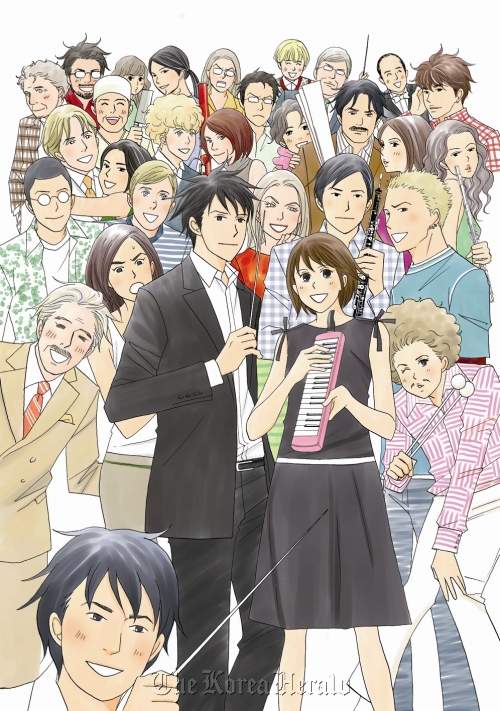Mr. Hanada, a taciturn but conscientious man, said he had spent months racking his brain. Then, one day he saw schoolchildren planting a rice paddy as a class project. They used two varieties of rice plants, one with dark purplish stalks and the other bright green ones. Then it struck him, why not plant the colored varieties in such a way as to form words and pictures?
“I didn’t know it would become such a hit,” he said.
The result was what is now called paddy art, and it has put this village on the map. Every year since 1993, villagers have created pictures by using rice paddies as their canvas and living plants as their paint and brush. As the village’s creations have grown increasingly large, complex and polychrome, they have drawn growing media attention and hordes of the curious.
Last year, more than 170,000 visitors clogged the narrow streets of this quiet community of 8,450 mostly older residents, causing traffic jams and waiting for hours to see the living art.
Indeed, the images may be possible only in Japan, as the product of an amalgam of high technology, painstaking perfectionism and an ancient attachment to rice. To create this year’s football field-size picture of a samurai battling a warrior monk, villagers used a computer model to place more than 8,000 stakes to guide them in planting rice plants genetically engineered to produce three more colors: dark red, yellow and white.
The images have become so detailed that the mayor, Koyu Suzuki, says visitors often ask if they are drawn on the paddies with paints. He said that it was the surprise factor that brought people here, and that the villagers believed they must produce ever more intricate pictures for tourists to keep coming back.
“We have no sea and no mountains, but what we do have plenty of is rice,” said Mr. Suzuki, 70. “We have to create a tourism industry using our own ingenuity.”
Residents of Inakadate (pronounced ee-NAH-kah-dah-tay) hope the paddy art will revitalize their declining village. Like much of rural Japan, the village has fallen on hard times from a shrinking population, a crushing debt load and declining revenues from agriculture.
“So many things have gone wrong, but the paddy art lets the community feel together again,” said Kumiko Kudo, 73, who runs a noodle restaurant.
But so far, the village has failed to turn its accomplishments on the rice paddies to its financial benefit. The visitors who now flood the village during the summer growing season, when the rice stalks grow tall enough for the pictures to become visible, do not spend much.
“Tourists come, say how wonderful it is and then just leave,” said Katsuaki Fukushi, the head of the village hall’s economic section.
Before the paddy art, the village’s only claim to fame was the discovery here in 1981 of the archaeological remains of 2,000-year-old rice paddies, making it one of the oldest rice-growing regions in sparsely populated northern Japan. The village tried to capitalize on the discovery by building a Neolithic-themed amusement park during the better economic times of the 1980s, when Tokyo showered regions with money for public works.
The public works spigot has since dried up, and the park now sits weed-filled and often empty. The park is one reason the village is now saddled with a debt of $106 million, three times as large as its total annual budget.
Villagers say the less expensive paddy art is better suited to the current leaner era. The paddies cost just $35,000 per year to rent, plant and maintain. While the village does not charge visitors to see the paddy art, it does ask for donations, which last year brought in $70,000, more than enough to cover the costs.
On a recent afternoon, throngs crowded an observation deck at the top of the village hall, which is built in the shape of a medieval Japanese castle, to see the paddy art below. Most praised Inakadate for its ingenuity.
“Other parts of Japan need to learn this spirit,” said Masako Sato, 69, a retired teacher from Akita, five hours away.
Volunteers plant and maintain the paddies. In the spring, about 1,200 villagers turned up to plant the half-dozen paddies for this year’s spectacle. That is a far cry from the first art in 1993, when Mr. Hanada and 20 fellow workers from the village hall made a simple, two-colored design representing a nearby mountain.
Along the way, the project has learned from its mistakes. In 2003, a picture of the Mona Lisa ended up looking pregnant, Mayor Suzuki said, because she was too narrow at the top and bloated at the bottom. To correct the sense of perspective, the villagers asked a teacher here to use a computer to map out where to plant stalks so the pictures would have proper proportions when viewed from atop village hall.
The village has also spawned imitators. At least a half-dozen other communities across Japan now create pictures in paddies, though none seem as intricate.
Feeling that they have been left to fend for themselves by Tokyo’s spending cuts, villagers say they must find ways to capitalize on the influx of visitors. Yozo Kikuchi, the head of the Chamber of Commerce, says the village must develop new souvenirs. True to form in Japan, they include a cute mascot, a smiling grain of rice named Little Mr. Rice-Rice.
The mayor has grander plans. He envisions increasing the number of paddy art sites and building new facilities for visitors, including possibly a flower-lined road, to turn Inakadate into an “art village.”
“We used to treat economic benefits as an afterthought,” said Eiji Kudo, head of the village council. “Now we realize how important they are.”






